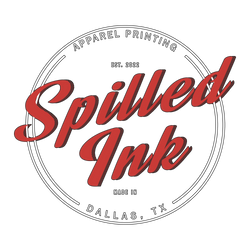DESIGN GUIDELINES
What Makes a Good Print File?
The Basics
While a good print file should be 300 dpi, uploading a pixelated image at 300 dpi will still result in a pixelated print. If your design looks pixelated at 300 dpi in the PSD file available below, the best fix would be to recreate it.
YouTube has tons of extremely helpful videos on how to fix pixelated/low res/blurry images.
Transparent Colors
Printing colored ink on apparel that matches that color (i.e. printing black ink on a black tee, printing red ink on a red tee, and so on) typically looks less appealing than turning that tee color transparent. Removing black (or red, or blue, or yellow, etc.) from your design when printing on a black tee is easy to do in both Adobe Photoshop and Adobe Illustrator - Again, plenty of videos on YouTube explaining the process.
Color Opacity
Semi-transparent colors - those colors or design elements with opacity set between 1% to 99% - do not translate well to DTG as they will print opaque. You can simulate opacity in colors using lighter or darker version of the original color - Check YouTube for Help!
Backgrounds
Every part of the image you send us to print will be printed. We don't know if a background is intended to be there or not. However, since all artwork needs to be print ready, we assume it is there on purpose. If you're using an image or part of an image you found online and it has a background of any color - even white or black - will print unless you remove it. In almost all situations removing the background from a print will much more aesthetically pleasing than a print with a background.
JPEG files by default have a solid white background once saved even if they were created with a transparent background. We prefer files be uploaded as PNGs. YouTube is a great source for learning how to remove backgrounds from images.
DTG Specifics
White tees are printed without a white base. Any white in your design will automatically be turned transparent - i.e. nothing will print where the white is.
There are no color count limits with DTG printing. Designs do not half to be half-toned like they would need to be if being screen printed, but if your design is already half-toned it will print as you intended.
The colors you see on your computer screen may vary slightly from the final printed product. Hue, saturation, brightness, and a dozen other monitor settings vary from screen to screen which in turn may lead to a design looking one way digitally and another in printed form.
Photoshop Print Guide
Download the PSD file below for a detailed guide and pre-prepped print guide. Make sure to save your final file as a PNG before uploading.
